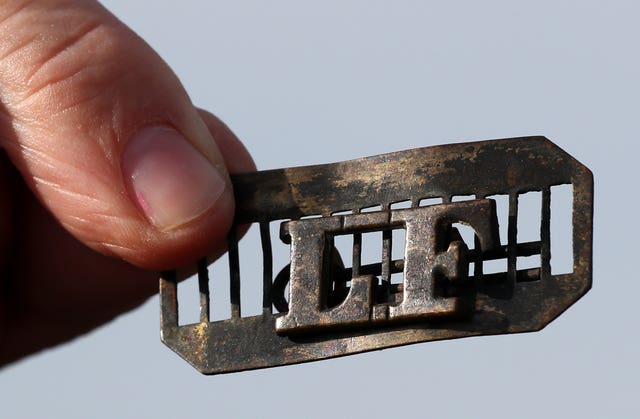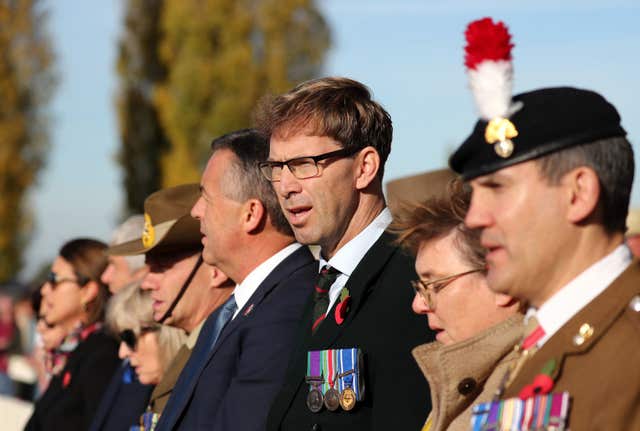
An unidentified British soldier who died in the First World War was laid to rest with full military honours in front of hundreds of people who turned out to pay their respects.
The body of the unknown man, who served in the Lancashire Fusiliers regiment, was buried alongside two Australian soldiers on Tuesday afternoon in Ypres, Belgium.
A ceremony at the Commonwealth War Graves Commission Tyne Cot Cemetery was attended by dignitaries, representatives from the regiment and crowds of members of the public.
The British soldier’s coffin was draped in a Union flag with a wreath of poppies laid on top alongside a belt and hat of the regiment.

After hymns, prayers and music, readings were given by dignitaries and a firing salute was conducted by the Royal Regiment and the Australian Army as the coffins were interred.
Research suggests the British soldier may have been killed on October 9, 1917, when he was aged between 23 and 29 while fighting in the Battle of Passchendaele which took place 101 years ago between July and November 1917.
The bodies of the three comrades were found lying side-by-side in what is thought to be a shell hole in May 2016 when water works were carried out on Vijfwegestraat, a road near the cemetery.
A pencil engraved with the name of Eagley Cricket Club, near Bolton, was found next to the British soldier alongside epaulettes of the regiment, service buttons, a belt, boots, fragments of a winter coat and a pipe.

Each year the remains of around 40 British soldiers who died in the First World War are found on battlefields in Europe and the Ministry of Defence’s Joint Casualty and Compassionate Centre (JCCC) – which is based at the cemetery and organised the ceremony – tries to identify them.
Tracey Bowers, of the JCCC, said the pencil was a “unique” find which alongside the shoulder titles suggested his links to Lancashire.
But despite extensive investigations looking into the history of the regiment, battalion war diaries, cricket club records and DNA, his identity has never been confirmed.
Tests were carried out to find out if a missing soldier who lived near the cricket club was a match but this proved unsuccessful.
Ms Bowers said: “With the centenary of the end of the First World War coming up it is particularly poignant.
“But also it is only right and proper that we try and give these brave soldiers their name on their headstone.”
She said there was a “wide pool” of people to research as on the day in question over 200 Lancashire Fusiliers were killed that still have no known grave.
Ms Bowers added: “We will continue with our research, we will look through the regimental diaries and war diaries to see if we can narrow it down. If we can, we will go out to families and take DNA and hopefully identify him.”
Research indicated the regiment had been posted to the area during what is known as the Third Battle of Ypres.
The battle lasted 105 days and capturing the village of Passchendaele, now entitled Passendale, came at the cost of an estimated 500,000 casualties. The bodies of 42,000 were never found.
Four battalions of the regiment were in the area during the later stages of the conflict, specifically during clashes in Poelcapelle which began on October 9, 1917 in a quagmire due to heavy rain.
The Lancashire Fusiliers existed from 1688 to 1968 before amalgamating with others to form what is now the Royal Regiment of Fusiliers. The regiment ended the First World War with 18 Victoria Crosses, more than any other in the British Army.
Captain Alexander Edmund, 1st Battalion of the Royal Regiment of the Fusiliers, who took part in the ceremony, said: “In one sense it’s sad, we obviously don’t know his identity but we know he was a member of our regiment and he is part of our story.
“It’s sad his family couldn’t be here but his army family are here and the hope is ultimately he will be identified.”
Minister for Defence Personnel, Welfare and Veterans Tobias Ellwood, who was among dignitaries paying their respects, said trying to identify soldiers and remembering the sacrifice they made was vital in helping future generations understand the conflict.

He said: “It’s so important that we say thank you to that individual for the sacrifice that he made in defending our values a hundred years ago.
“It’s so moving to be at Tyne Cot Cemetery.
“It places in perspective the scale of the sacrifice that was made 100 years ago. These numbers are almost too profound to understand.”
Two thirds of the cemetery’s 12,000 headstones do not have names on while the wall surrounding it has 34,000 names of people who are still missing, he said.


Comments: Our rules
We want our comments to be a lively and valuable part of our community - a place where readers can debate and engage with the most important local issues. The ability to comment on our stories is a privilege, not a right, however, and that privilege may be withdrawn if it is abused or misused.
Please report any comments that break our rules.
Read the rules here